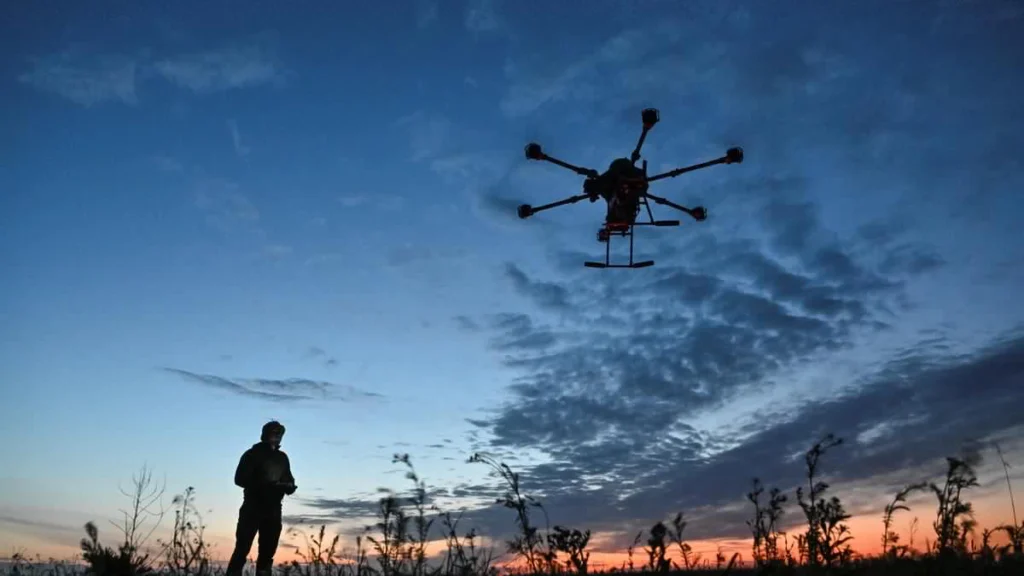Ukraine’s drones target Moscow, other regions: Russian Defence Ministry

In a significant escalation, Ukraine launched drone attacks on Moscow and several regions in Russia. The Russian Defence Ministry reported that more than half of the drones were intercepted over Belgorod, Kursk, and Bryansk, regions that border Ukraine. However, some drones managed to penetrate defences, causing damage and injuries.
A New Phase in the Conflict
Ukraine’s drone operations are growing more frequent and effective. These drones, although small and low-cost, have been devastating for Russia. Ukraine uses them to attack military targets, supply lines, and key infrastructure deep inside Russian territory. The recent attacks on Belgorod, Kursk, and Bryansk highlight Ukraine’s increasing ability to strike at the heart of Russia’s war effort.
The drone attacks focused on military bases, airfields, and logistics hubs. These targets are essential to Russia’s military operations. The Ukrainian strikes show a growing trend of using unmanned aerial vehicles (UAVs) to disrupt the enemy’s strategic advantage without risking human lives.
The Impact on Belgorod, Kursk, and Bryansk
The regions most affected by the strikes were Belgorod, Kursk, and Bryansk. These areas are critical to Russian defence and logistics, and attacks on these regions damage Russia’s ability to launch effective operations.
- Belgorod: Belgorod has suffered multiple attacks, and the recent drone strike caused significant damage to military infrastructure. This city plays a key role in supplying Russian forces near the Ukrainian border.
- Kursk: Kursk, another key region, reported drone strikes that targeted transport links and military logistics. Disruptions here can delay Russian reinforcements and supplies.
- Bryansk: Bryansk, vital for Russian troops, faced similar attacks. Damage to its transportation infrastructure could hamper Russian logistics and troop movements.
Moscow Under Attack
Moscow, Russia’s capital, also came under attack. While most drones were destroyed before reaching the city, the attack proved that Ukraine’s reach has expanded. The strikes on Moscow were a warning to Russia, showing that even the most secure cities are vulnerable.
The damage in Moscow was limited, but the attacks raised questions about Russia’s preparedness to defend critical infrastructure. Moscow’s air defences intercepted many drones, but some caused minor damage to buildings and infrastructure on the outskirts.
Russian Defence Ministry’s Response
The Russian Defence Ministry confirmed that its air defences destroyed most of the incoming drones. They praised the efforts of Russia’s air defence systems, including the S-400 and Pantsir missile systems. However, the Ministry admitted that the strikes had exposed vulnerabilities, especially in regions close to Ukraine.
Despite Russia’s successful interception of many drones, the damage done by those that made it through was significant. The Ministry also acknowledged civilian casualties in Belgorod and Kursk but did not provide precise figures.
The Role of Drones in Modern Warfare
Drones have become a key tool in modern warfare. Their ability to strike at targets without risking human life has made them increasingly attractive for both sides in this conflict. Ukraine has successfully used drones to target Russian military assets, weakening their defence lines.
Drones are relatively low-cost, flexible, and can carry out precise attacks. These characteristics make them particularly effective in asymmetrical warfare. Ukraine’s successful use of drones shows how smaller nations can level the playing field against more powerful adversaries.
International Reactions
The drone strikes have drawn mixed reactions globally. Many Western countries have expressed support for Ukraine’s right to defend itself, while urging both sides to de-escalate. Russia, however, condemned the strikes as an act of terrorism. Russian officials called for stronger air defences to protect civilian and military infrastructure from future attacks.
The international community continues to call for peace talks, but the conflict remains far from resolution. The growing use of drones by Ukraine adds complexity to the already volatile situation, and both sides may see an increase in these kinds of attacks.
The Future of Drone Warfare
The continued use of drones in the Ukraine-Russia conflict marks a turning point in modern warfare. Countries worldwide will likely invest in drone technology as it becomes an increasingly important aspect of both offensive and defensive military strategies. Drones allow countries to engage in warfare without risking significant loss of life.
The attacks on Russian regions have proven that drones can target critical infrastructure, disrupt logistics, and create chaos. For Ukraine, drones offer a way to fight back without the need for large, costly military operations. For Russia, the attacks serve as a reminder that no territory, no matter how well-defended, is safe from modern weaponry.
The Way Forward
Ukraine’s increasing use of drones signals a shift in the conflict’s dynamics. As Russia improves its air defence systems, Ukraine will likely continue to innovate in its use of UAVs. Both sides are expected to adopt more advanced technologies, making future confrontations more unpredictable.
The international community must continue to support peace efforts. While drones may play an important role in modern warfare, they should not replace diplomatic efforts to end the conflict. Continued military escalation is harmful to both sides and the millions of civilians caught in the crossfire.
Conclusion
The drone attacks on Belgorod, Kursk, Bryansk, and Moscow have added a new layer of complexity to the conflict. Ukraine’s ability to strike deep into Russian territory shows that drones are not just a tactical advantage—they are shaping the future of warfare. As both sides adapt to this new reality, the world must hope for peace and a diplomatic resolution to the conflict.






